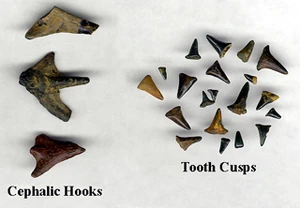| Hybodus Fossil range: Late Permian to Early Cretaceous | |
|---|---|
 H. fraasi from Eichstätt, Germany in the Museum für Naturkunde in Berlin. | |
| Scientific classification
| |
|
Hybodontoidea | |
|
Hybodus | |
|
See text. | |

Hybodus (from Benton, 2005)
Hybodus ("humped tooth") is an extinct genus of shark represented in the fossil records of Asia, Europe, Africa and North America by skeletons, isolated teeth, and head and fin spines. The genus first appeared towards the end of the Permian period, and disappearing at the beginning of the Cretaceous (230-90 million years ago). During the Triassic, Jurassic, and Cretaceous periods the hybodonts were especially successful and could be found in shallow seas across the world. For reasons that are not fully understood, the hybodonts became extinct near the end of the Cretaceous period.
Hybodus species grew to about 2 m in length, and are believed to have been opportunist predators. It was not very big, but had the classic streamlined shark shape, complete with two dorsal fins that would have helped it steer with precision. The mouth was not large, and rather than ruthlessly hunt large prey, Hybodus, was capable of eating a wide range of foods. They had several distinct features that made them stand apart from other primitive sharks: they had two different types of teeth (both sharp and flat), suggesting a wide diet (sharp for catching slippery prey, flat for crushing shelled creatures) , a bony blade on their dorsal fin for apparent protection, and the development of "claspers". These specialized organs aid males in reproduction by directly inserting sperm into the female. This last development has been passed on to modern sharks.
Fossils[]

Hybodus fossils from New Jersey include isolated teeth and cephalic hooks, like the ones shown here, plus occasional dorsal fin spines.

A complete fin spine of Hybodus from the Bathonian limestones of Lincolnshire, England.

Hybodont spine from Morocco. In hybodonts, such spines were mounted at the leading edges of the dorsal and pectoral fins.

A 3-D model of Hybodus clearly showing the cephalic spines on it's head.
The first fossilized teeth from Hybodus were found in England around 1845. Since then teeth (and occasionally dorsal spines) have been recovered from around the world.According to Maisey (1996: 104-06), these were marine sharks, but some species would enter freshwater.
Teeth[]
Hybodus dentition as generally being a clutching-type. Later, in some species, the central cusps are larger and lateral(s) reduced, creating a tearing-type dentition. The Hybodus tooth is laterally expanded (to 2 cm) with a large central cusp bearing enameloid ridges and a distinct cutting edge. One or more, smaller, lateral cusps are present. The (weakly) lingually directed root is relatively short and thin. The basal and lingual faces have numerous scattered foramina.
Isolated teeth from this genus are usually fragmentary and lacking roots. Elongated, knife-like dorsal spines are relatively common. Those from Hybodus sp. are covered with enameloid tubercles (laterally) and have a serrate posterior edge. The H. montanensis dorsal spine is similar, but has elongated enameloid ridges on the side and is thicker in cross-section.
Species[]
- Hybodus houtienensis
- ?Hybodus butleri
- ?Hybodus obtusus
- ?Hybodus parvidens
- ?Hybodus rajkovichi
- Hybodus nevadensis WEMPLE 1906 (Middle Triassic of Nevada),
- Hybodus shastensis WEMPLE 1906 (Late Triassic of California),
- Hybodus montanensis CASE 1978 (Campanian, Upper Cretaceous of Montana),
- Hybodus butleri THURMOND 1971 (Aptian-Albian of Texas) and
- Hybodus sp, an undescribed species found in Campanian deposits from New Jersey to Georgia.
See also[]
References[]
- Haines, Tim, and Paul Chambers. The Complete Guide to Prehistoric Life. Pg. 89. Canada: Firefly Books Ltd., 2006.

